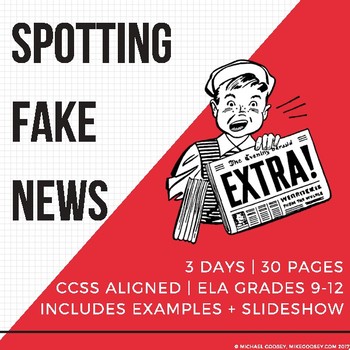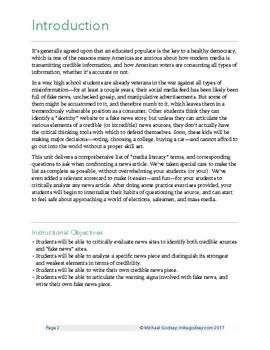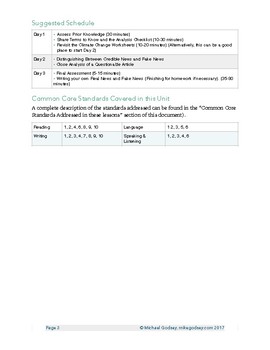Credible or "Fake News"? Cultivating News Literacy in a "Post-Truth" Era
Mike and Melissa Godsey
581 Followers
Grade Levels
9th - 12th
Resource Type
Standards
CCSSCCRA.R.1
CCSSCCRA.R.2
CCSSCCRA.R.4
CCSSCCRA.R.5
CCSSCCRA.R.6
Formats Included
- Zip
Pages
20 pages
Mike and Melissa Godsey
581 Followers
Description
These lessons cover the basics of discerning between credible and false journalism (and the gradient between the two), using contemporary (but non-controversial) examples. There is also a slideshow (in PDF format) with links to examples of terms, as well as examples of credible journalism.
Arguably the most tangibly helpful aspect of this three-day unit is the "News Analysis Checklist" which students can apply to any form of journalism to asses its credibility. The checklist is available in PDF, as well as Google Drive, for those of you using Google Classroom.
For those who use the CCSS, each lesson has been carefully CCSS aligned (as reflected throughout the unit).
Common Core with Uncommon Literature is happy to share these lessons with you, and ask that if you enjoy them to please rate them here, and tell others what you think. We appreciate your support, and would love to hear your feedback. You can find us on Twitter at @TheMrGodsey, and on the web at www.mrgodsey.com.
Standards-Based Serial by Michael Godsey is licensed under a Creative Commons Attribution-NonCommercial-NoDerivatives 4.0 International License.
Arguably the most tangibly helpful aspect of this three-day unit is the "News Analysis Checklist" which students can apply to any form of journalism to asses its credibility. The checklist is available in PDF, as well as Google Drive, for those of you using Google Classroom.
For those who use the CCSS, each lesson has been carefully CCSS aligned (as reflected throughout the unit).
Common Core with Uncommon Literature is happy to share these lessons with you, and ask that if you enjoy them to please rate them here, and tell others what you think. We appreciate your support, and would love to hear your feedback. You can find us on Twitter at @TheMrGodsey, and on the web at www.mrgodsey.com.
Standards-Based Serial by Michael Godsey is licensed under a Creative Commons Attribution-NonCommercial-NoDerivatives 4.0 International License.
Total Pages
20 pages
Answer Key
Included
Teaching Duration
2 days
Report this resource to TPT
Reported resources will be reviewed by our team. Report this resource to let us know if this resource violates TPT’s content guidelines.
Standards
to see state-specific standards (only available in the US).
CCSSCCRA.R.1
Read closely to determine what the text says explicitly and to make logical inferences from it; cite specific textual evidence when writing or speaking to support conclusions drawn from the text.
CCSSCCRA.R.2
Determine central ideas or themes of a text and analyze their development; summarize the key supporting details and ideas.
CCSSCCRA.R.4
Interpret words and phrases as they are used in a text, including determining technical, connotative, and figurative meanings, and analyze how specific word choices shape meaning or tone.
CCSSCCRA.R.5
Analyze the structure of texts, including how specific sentences, paragraphs, and larger portions of the text (e.g., a section, chapter, scene, or stanza) relate to each other and the whole.
CCSSCCRA.R.6
Assess how point of view or purpose shapes the content and style of a text.





